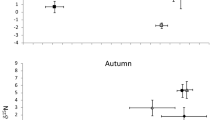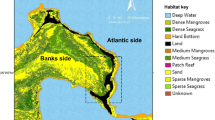Abstract
River discharge supplies nearshore communities with a terrestrial carbon source that is often reflected in invertebrate and fish consumers. Recent studies in the Beaufort Sea have documented widespread terrestrial carbon use among invertebrates, but only limited use among nearshore fish consumers. Here, we examine the carbon source and diet of rapidly growing young-of-year Arctic cisco (Coregonus autumnalis) using stable isotope values (δ13C and δ15N) from muscle and diet analysis (stomach contents) during a critical and previously unsampled life stage. Stable isotope values (δ15N and δ13C) may differentiate between terrestrial and marine sources and integrate over longer time frames (weeks). Diet analysis provides species-specific information, but only from recent foraging (days). Average δ13C for all individuals was −25.7 ‰, with the smallest individuals possessing significantly depleted δ13C values indicative of a stronger reliance of terrestrial carbon sources as compared to larger individuals. Average δ15N for all individuals was 10.4 ‰, with little variation among individuals. As fish length increased, the proportion of offshore Calanus prey and neritic Mysis prey increased. Rapid young-of-year growth in Arctic cisco appears to use terrestrial carbon sources obtained by consuming a mixture of neritic and offshore zooplankton. Shifts in the magnitude or phenology of river discharge and the delivery of terrestrial carbon may alter the ecology of nearshore fish consumers.




Similar content being viewed by others

References
Audzijonytė A, Väinölä R (2005) Diversity and distributions of circumpolar fresh- and brackish-water Mysis (Crustacea: Mysida): Descriptions of M. relicta Lovén, 1862, M. salemaai n. sp., M. segerstralei n. sp. and M. diluviana n. sp., based on molecular and morphological characters. Hydrobiologia. doi:10.1007/s10750-004-8337-7
Bogorov BG (1959) On the standardisation of marine plankton investigations. Int Revue Gesamten Hydrobiol Hydrogr. doi:10.1002/iroh.19590440135
Bradstreet MSW, Cross WE (1982) Trophic relationships at high Arctic ice edges. Arctic 35:1–12
Bremigan MT, Stein RA (1994) Gape-dependent larval foraging and zooplankton size: implications for fish recruitment across systems. Can J Fish Aquatic Sci. doi:10.1139/cjfas-51-4-913
Caddy JF (2000) Marine catchment basin effects versus impacts of fisheries on semi-enclosed seas. ICES J Mar Sci. doi:10.1006/jmsc.2000.0739
Carmack EC, Macdonald RW (2002) Oceanography of the Canadian Shelf of the Beaufort Sea: a setting for marine life. Arctic 55:29–45
Colonell JM, Gallaway BJ (1997) Wind-driven transport and dispersal of age-0 Arctic cisco along the Beaufort Sea coast. Am Fish Soc Symp 19:90–103
Craig PC (1989) An introduction to anadromous fishes of the Alaskan Arctic. Biol Pap Univ Alaska 24:27–54
Darnaude AM (2005) Fish ecology and terrestrial carbon use in coastal areas: implications for marine fish production. J Anim Ecol. doi:10.1111/j.1365-2656.2005.00978.x
Dillinger EEJ, Birt TP, Green JM (1992) Arctic cisco, Coregonus autumnalis, distribution, migration and spawning in the Mackenzie River. Can Field Nat 106:175–180
Dittmar T, Kattner G (2003) The biogeochemistry of the river and shelf ecosystem of the Arctic Ocean: a review. Mar Chem. doi:10.1016/S0304-4203(03)00105-1
Dunton K, Weingartner T, Carmack E (2006) The nearshore western Beaufort Sea ecosystem: circulation and importance of terrestrial carbon in arctic coastal food webs. Prog Oceanogr. doi:10.1016/j.pocean.2006.09.011
Dunton KH, Schonberg SV, Cooper LW (2012) Food web structure of the Alaskan nearshore shelf and estuarine lagoons of the Beaufort Sea. Estuar Coast. doi:10.1007/s12237-012-9475-1
Emmerton CA, Lesack LFW, Vincent WF (2008) Mackenzie River nutrient delivery to the Arctic Ocean and effects of the Mackenzie Delta during open water conditions. Global Biogeochem Cycles. doi:10.1029/2006GB002856
Fechhelm RG, Griffiths WB (1990) Effect of wind on the recruitment of Canadian Arctic cisco (Coregonus autumnalis) into the central Alaskan Beaufort Sea. Can J Fish Aquatic Sci. doi:10.1139/f90-241
Fechhelm RG, Martin LR, Gallaway BJ, Wilson WJ, Griffiths WB (1999) Prudhoe Bay causeways and the summer coastal movements of Arctic cisco and least cisco. Arctic 52:139–151
Fechhelm RG, Streever B, Gallaway BJ (2007) The Arctic cisco (Coregonus autumnalis) subsistence and commercial fisheries, Colville River, Alaska: a conceptual model. Arctic 60:421–429
Feuchtmayr H, Grey J (2003) Effect of preparation and preservation procedures on carbon and nitrogen stable isotope determinations from zooplankton. Rapid Commun Mass Spectrom. doi:10.1002/rcm.1227
Gallaway BJ, Griffiths WB, Craig PC, Gazey WJ, Helmericks JW (1983) An assessment of the Colville River delta stock of Arctic cisco—migrants from Canada? Biol Pap Univ Alaska 21:4–23
Gronvik S, Hopkins CCE (1984) Ecological investigations of the zooplankton community of Balsfjorden, Northern Norway: generation cycle, seasonal vertical distribution, and season variations in body weight and carbon and nitrogen content of the copepod Metridia longa. J Exp Mar Biol Ecol 80:93–107
Hirche J (1997) Life cycle of the copepod Calanus hyperboreus in the Greenland Sea. Mar Biol. doi:10.1007/BF00392894
Holmes RM, McClelland JW, Raymond PA, Frazer BB, Peterson BJ, Stieglitz M (2008) Liability of DOC transported by Alaskan rivers to the Arctic Ocean. Geophys Res Lett. doi:10.1029/2007GL032837
Hopky GE, Lawrence MJ, Chiperzak DB (1994) NOGAP B2: Zooplankton data from the Canadian Beaufort Sea Shelf, 1984 and 1985. Canadian Data Report of Fisheries and Aquatic Sciences 923
Horner R, Murphy D (1985) Species composition and abundance of zooplankton in the nearshore Beaufort Sea in winter-spring. Arctic 38:201–209
Hunt GL, Coyle KO, Eisner LB, Farley EV, Heintz RA, Mueter F, Napp JM, Overland JE, Ressler PH, Salo S, Stabeno PJ (2011) Climate impacts on eastern Bering Sea foodwebs: a synthesis of new data and an assessment of the Oscillating Control Hypothesis. ICES J Mar Sci. doi:10.1093/icesjms/fsr036
Jarvela LE, Thorsteinson LK (1999) The epipelagic fish community of Beaufort Sea coastal waters, Alaska. Arctic 52:80–94
Kline J, Thomas C, Wilson WJ, Goering JJ (1998) Natural isotope indicators of fish migration at Prudhoe Bay, Alaska. Can J Fish Aquatic Sci. doi:10.1139/cjfas-55-6-1494
Kling GW, Fry B, O’Brien WJ (1992) Stable isotopes and planktonic trophic structure in Arctic lakes. Ecology 73:561–566
Logan JM, Jardine TD, Miller TJ, Bunn SE, Cunjak RA, Lutcavage ME (2008) Lipid corrections in carbon and nitrogen stable isotope analyses: Comparison of chemical extraction and modeling methods. J Anim Ecol. doi:10.1111/j.1365-2656.2008.01394.x
Lowry LF, Burns JJ (1979) Foods utilized by bowhead whales near Barter Island, Alaska, autumn 1979. Mar Fish Rev 42:88–91
Naesje TF, Jonsson B, Sandlund OT (1986) Drift of cisco and whitefish larvae in a Norwegian River. Trans Am Fish Soc 115:89–93
Naesje TF, Jonsson B, Skurdal J (1995) Spring flood: a primary cue for hatching of river spawning Coregoninae. Can J Fish Aquatic Sci. doi:10.1139/f95-811
Perga ME, Gerdeaux D (2005) “Are fish what they eat” all year round? Oecologia doi:10.1007/s00442-005-0069-5
Peterson BJ, Holmes RM, McClelland JW, Vörösmarty CJ, Lammers RB, Shiklomanov AI, Rahmstorf S (2002) Increasing river discharge to the Arctic Ocean. Science. doi:10.1126/science.1077445
Post DM (2002) Using stable isotopes to estimate trophic position: Models, methods, and assumptions. Ecology. doi:10.2307/3071875
Post DM, Layman CA, Arrington DA, Takimoto G, Quattrochi J, Montaña CG (2007) Getting to the fat of the matter: models, methods and assumptions for dealing with lipids in stable isotope analyses. Oecologia. doi:10.1007/s00442-006-0630-x
Prokopowicz A, Fortier L (2002) Population structure of three dominant Calanus species in North Water Polynya, Baffin Bay. Pol Polar Res 23:241–252
Retamal L, Bonilla S, Vincent WF (2008) Optical gradients and phytoplankton production in the Mackenzie River and the coastal Beaufort Sea. Polar Biol. doi:10.1007/s00300-007-0365-0
Romare P, Bergman E, Hansson LA (1999) The impact of larval and juvenile fish on zooplankton and algal dynamics. Limnol Oceanogr. doi:10.4319/lo.1999.44.7.1655
Salen-Picard C, Darnaude A, Arlhac D, Harmelin-Vivien M (2002) Fluctuations of macrobenthic populations: a link between climate-driven river run-off and sole fishery yields in the Gulf of Lions. Oecologia. doi:10.1007/s00442-002-1032-3
Schlacher TA, Connolly RM, Skillington AJ, Gaston TF (2008) Can export of organic matter from estuaries support zooplankton in nearshore, marine plumes? Aquat Ecol. doi:10.1007/s10452-008-9196-5
Scott CL, Kwasniewski S, Falk-Petersen S, Sargent JR (2000) Lipids and life strategies of Calanus finmarchicus, Calanus glacialis and Calanus hyperboreus in late autumn, Kongsfjorden, Svalbard. Polar Biol. doi:10.1007/s003000000114
Stewart DB, Bernier LMJ (1999) Common parasites, diseases and injuries of freshwater fishes in the Northwest Territories and Nunavut. Prepared by Arctic Biological Consultants for the Canada Department of Fisheries and Oceans, Central and Arctic Region, Winnipeg
Tamelander T, Kivimäe C, Bellerby RGJ, Renaud PE, Kristiansen S (2009) Base-line variations in stable isotope values in an Arctic marine ecosystem: effects of carbon and nitrogen uptake by phytoplankton. Hydrobiologia. doi:10.1007/s10750-009-9780-2
Tomy GT, Pleskach K, Ferguson SH, Hare J, Stern G, MacInnis G, Marvin CH, Loseto L (2009) Trophodynamics of some PFCs and BFRs in a Western Canadian Arctic marine food web. Environ Sci Technol. doi:10.1021/es900162n
Urpanen O, Huuskonen H, Marjomäki TJ (2005) Growth and size-selective mortality of vendace (Coregonus albula (L.)) and whitefish (C. lavaretus (L.)) larvae. Boreal Environ Res 10:225–238
Uye S (1994) Replacement of large copepods by small ones with eutrophication of embayments: Cause and consequence. Hydrobiologia. doi:10.1007/BF00229979
Vander Zanden MJ, Rasmussen JB (2001) Variation in δ15N and δ13C trophic fractionation: implications for aquatic food web studies. Limnol Oceanogr 46:2061–2066
Vinagre C, Maguas C, Cabral HN, Costa MJ (2011a) Effect of body size and body mass on δ13C and δ15N in coastal fishes and cephalopods. Estuar Coast Shelf Sci. doi:10.1016/j.ecss.2011.08.006
Vinagre C, Maguas C, Cabral HN, Costa MJ (2011b) Nekton migration and feed location in a coastal area—a stable isotope approach. Estuar Coast Shelf Sci. doi:10.1016/j.ecss.2010.12.011
Vinagre C, Salgado J, Cabral HN, Costa MJ (2011c) Food web structures and habitat connectivity in fish estuarine nurseries—impact of river flow. Estuar Coasts. doi:10.1007/s12237-010-9315-0
Vizzini S, Mazzola A (2003) Seasonal variations in the stable carbon and nitrogen isotope ratios (13C/12C and 15N/14N) of primary producers and consumers in a western Mediterranean coastal lagoon. Mar Biol. doi:10.1007/s00227-003-1027-6
von Biela VR, Zimmerman CE, Moulton LL (2011) Long-term increases in young-of-the-year growth of Arctic cisco (Coregonus autumnalis) and environmental influences. J Fish Biol. doi:10.1111/j.1095-8649.2010.02832.x
Walkusz W, Paulić JE, Kwaśniewski S, Williams WJ, Wong S, Papst MH (2010) Distribution, diversity and biomass of summer zooplankton from the coastal Canadian Beaufort Sea. Polar Biol. doi:10.1007/s00300-009-0708-0
Weidel BC, Carpenter SR, Kitchell JF, Vander Zanden MJ (2011) Rates and components of carbon turnover in fish muscle: insights from bioenergetics models and a whole-lake 13C addition. Can J Fish Aquatic Sci. doi:10.1139/F10-158
Wold A, Darnis G, Søreide JE, Leu E, Philippe B, Fortier L, Poulin M, Kattner G, Graeve M, Falk-Petersen S (2011) Life strategy and diet of Calanus glacialis during the winter-spring transition in Amundsen Gulf, south-eastern Beaufort Sea. Polar Biol. doi:10.1007/s00300-011-1062-6
Wrona FJ, Prowse TD, Reist JD, Hobbie JE, Levesque LMJ, Vincent WF (2006) Climate impacts on Arctic freshwater ecosystems and fisheries: background, rationale and approach of the Arctic Climate Impact Assessment (ACIA). Ambio. doi:10.1579/0044-7447(2006)35[326:CIOAFE]2.0.CO;2
Zimmerman CE, Ramey AM, Turner SM, Mueter FJ, Murphy SM, Nielsen JL (Submitted to) Genetics, recruitment, and migration patterns of Coregonus autumnalis in the Colville River, Alaska and Mackenzie River, Canada. J Fish Biol
Acknowledgments
Sample collections were made available to our laboratory by R. Fechhelm at LGL Limited with the consent of B. Streever and BP under Fish Resource Permit CF-09-109 issued by the State of Alaska, Department of Fish and Game. Diet analyses were conducted by T. C. Stark at the University of Alaska Fairbanks and S. E. Burril at the U.S. Geological Survey Alaska Science Center. K. H. Dunton provided constructive comments on this manuscript. Funding was provided by the U.S. Geological Survey and the Bureau of Ocean Energy Management with the assistance of K. Wedemeyer. Support by NSF for the Environmental and Natural Resources Institute stable isotope facility was provided by MRI grant 0953271 awarded to JMW. Any use of trade names or products is for descriptive purposes only and does not imply endorsement of the US Government.
Author information
Authors and Affiliations
Corresponding author
Rights and permissions
About this article
Cite this article
von Biela, V.R., Zimmerman, C.E., Cohn, B.R. et al. Terrestrial and marine trophic pathways support young-of-year growth in a nearshore Arctic fish. Polar Biol 36, 137–146 (2013). https://doi.org/10.1007/s00300-012-1244-x
Received:
Revised:
Accepted:
Published:
Issue Date:
DOI: https://doi.org/10.1007/s00300-012-1244-x



